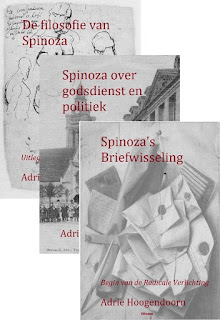Was de naturalist en rationalist Spinoza tegelijk ook een mysticus? [7] de casus Yovel
De verbinding die Spinoza lijkt te maken tussen het naturalistische en religieuze/mystieke vraagt a.h.w. om een oplossing, wat meestal niet in weinige woorden zoals van een Bennett kan worden afgedaan. Een voorbeeld van duiding om met beide aspecten in het reine te komen, is te vinden bij
 Yirmiyahu Yovel in
Spinoza and Other Heretics: The Marrano of Reason (1989):
Yirmiyahu Yovel in
Spinoza and Other Heretics: The Marrano of Reason (1989):
Reason thus inherits the supreme goals and ambitions that were traditionally assigned to mysticism and to historical religion. The pursuit of rationality does not end in knowledge but in beatitude, eternity, and rational love. For this purpose however, reason cannot be mere ratio (as in the second kind of knowledge), but must, as in the third, take the shape of scientia intuition; it cannot be merely analytic and discursive, but must be also construed as synoptic and intuitive. The distinction between these two types of rationality—between the second and third kinds of knowledge—is thus tightly related to the absolute task of reason, to serve not only as a way to knowing the world, but to the supreme ethical and spiritual goals that religion calls salvation.
In stressing this Marrano-like aspect of Spinoza I attribute to him an affinity with the ideals of mysticism and revealed religion, although the way he suggested is radically opposed to theirs. Unlike other modern philosophers, Spinoza never gave up the absolute spiritual goals of the religious mystics, but he thought that reason itself, shaped as scientia intuitiva and as the most potent mental power, can lead to these goals, and is the only way to reach them. Mysticism is irrational, confused, a form of the imaginatio; its goals are to be attained only by its opposite, and insofar as they require love and unity with God, this love must be intellectual, based upon the third kind of knowledge, and God and the soul's unity with God must be duly understood and interpreted—that is, outside all historical religion. Neither the love of Christ, the Law of Moses, or the confused and ineffable mystical experience can lead the soul to where it necessarily aspires by its nature; this can only be done in ways that, while retaining the basic ambitions of the mystic and the religious devotee, are utterly opposed to their practices.
In this respect, Spinoza resembles Plato and, in a different way, Hegel. Despite the great differences in the nature of their systems, all three were rationalists seeking to attain semimystical results by the power of reason--and distinguishing, as they had to, between two kinds of rationality, a lower, analytic, scientific kind and a higher, synoptic, semi-intuitive kind. Spinoza can be seen also as secularizing religion without giving up its absolute pathos, or as sacralizing reason by giving it the supreme spiritual tasks that were wrongly attributed [p. 37]
In Spinoza, although the life and ethics of reason are marked by naturalism, this does not make them banal and prosaic. On the contrary, some of the major drives that had in the past animated religion and even mysticism are still partly at work within Spinoza's naturalist rationalism: and, to preserve this essential feature, it is indispensable to continue using some of the old vocabulary, above all the word God in its new and daring association with "nature." Neither of these two terms can be abandoned, since it is their conjunction in deus seu natura which transmits Spinoza's actual message—both naturalizing God and sacralizing nature. [p. 148 – books.google]
* * *
Of het vergelijkbaar is, weet ik niet, want van de volgende publicatie heb ik alleen toegang tot het abstract, maar het lijkt me een voorbeeld van een vergelijkbare “verzoeningspogingen.”
Tsypina, L.V., "Mysticism without mystery": once more about Spinoza's "Deus sive Natura". In: Vestnik Sankt-Peterburgskogo universiteta, Seriia 7: Geologia, G; Dec 2013, Issue 4, p147
The author attempts to consider Spinoza's heritage in the post secular context where the boundaries between rational and mystical are blurred. It explores the possibility to use the language of the analysis of mysticism to discuss the famous statement of the philosopher, namely "Deus sive Natura". The meaning of this statement as a means to reconcile contradicting features of theistic and non-theistic, extrovertive and introvertive mysticism is tested textologically. The author analyses such important Spinoza's notions as substance, God, bearing nature (natura naturans) and born nature (natura naturata). The conclusion of the article is that the idealistic monism and its religious substrate, mystical monotheism, may be considered as "mysticism without mystery" due to the rationalist (geometrical) method which is immanent to the philosophical content of his doctrine. [Cf.]


Reacties
Stan,
Ik kan je besluit heel goed volgen, zeker waar je eindigt met Yovel, die in je blogreeks op mij de beste indruk gemaakt heeft. Maar het "mystieke" deel van de Ethica (2e helft van E5) blijft voor mij toch moeilijk te verteren. Zowel Yovel als jij stellen terecht dat je dit deel niet meer puur rationeel kan begrijpen, maar dat je beroep moet doen op intuïtie, de derde soort kennis. Hier heb ik moeite mee: volgens mijn interpretatie van Spinoza's kennissoorten moet intuïtieve kennis ook op rationele manier kunnen onderbouwd worden. Spinoza levert een overtuigende rationele onderbouwing in de Ethica tot en met de 1e helft van E5, maar in het resterend gedeelte faalt hij, hoewel hij heel hard probeert. In die zin heeft Bennett gelijk: puur logisch houdt de 2e helft van E5 geen steek, en het is heel eigenaardig dat Spinoza dit zelf niet gemerkt heeft.
Mark Behets 16-04-2015 @ 23:26
Sorry, bovenstaande reactie was bedoeld voor het conclusie-blog.
Mark Behets 16-04-2015 @ 23:30